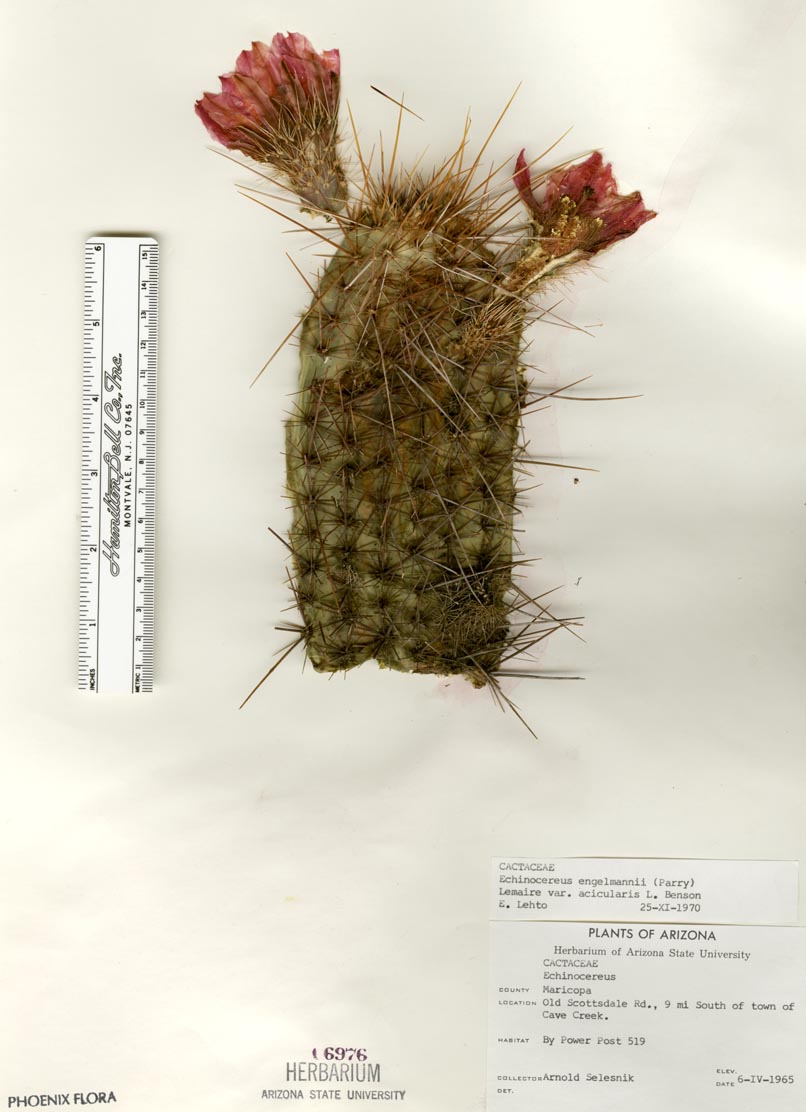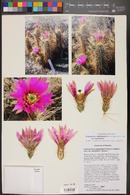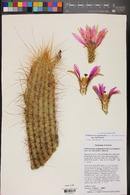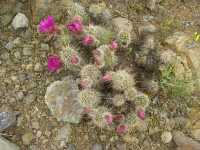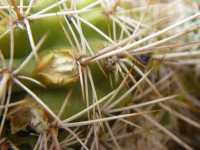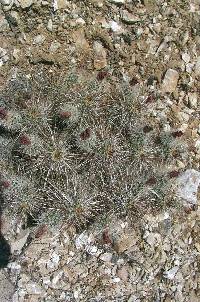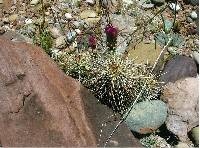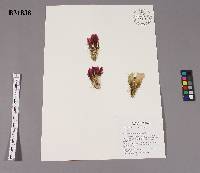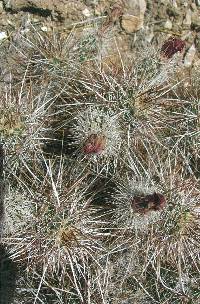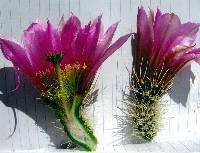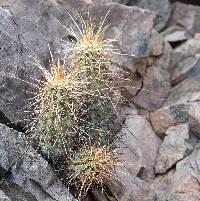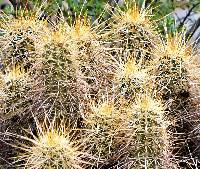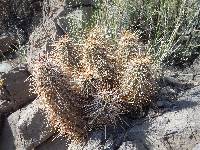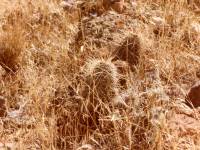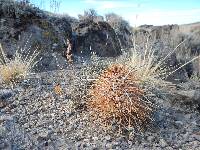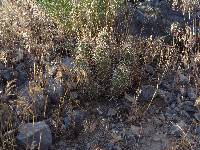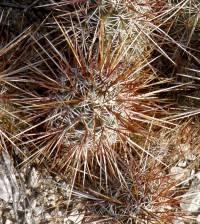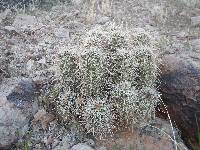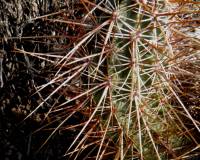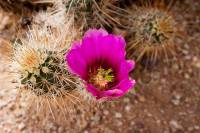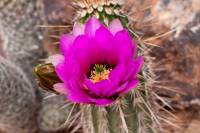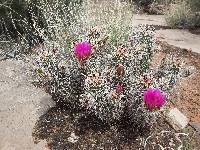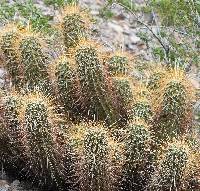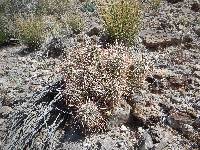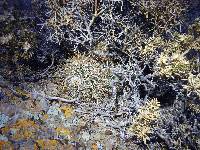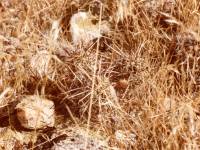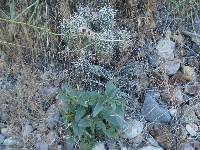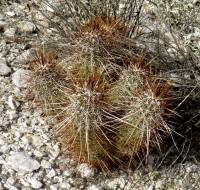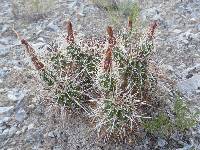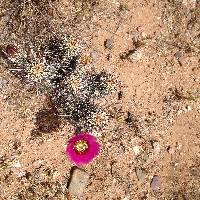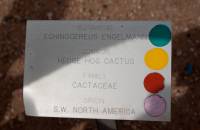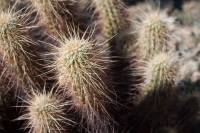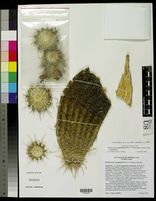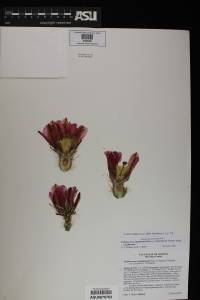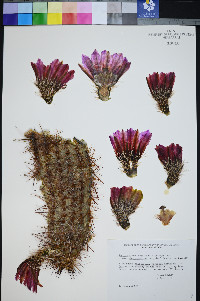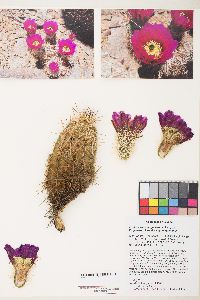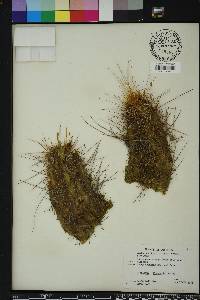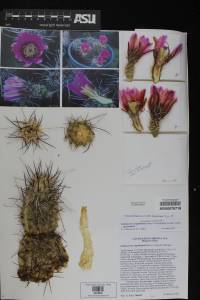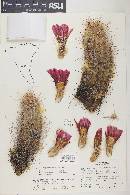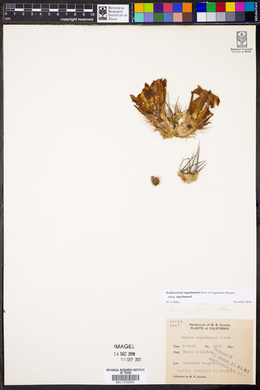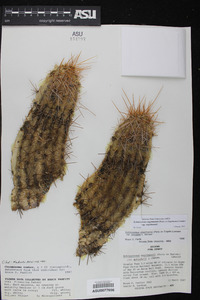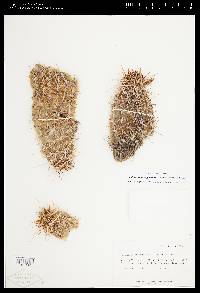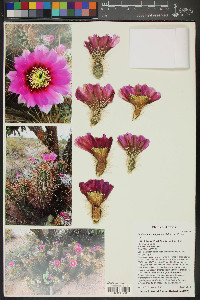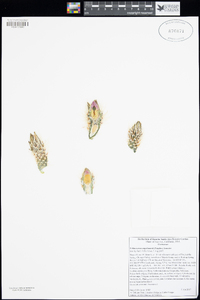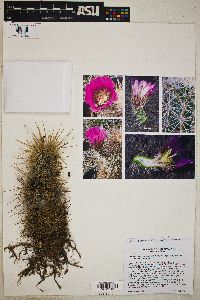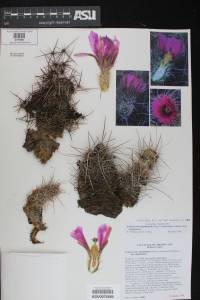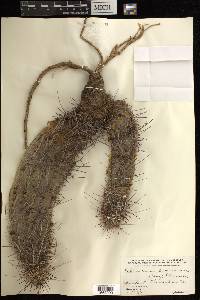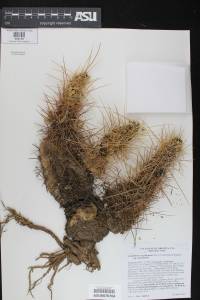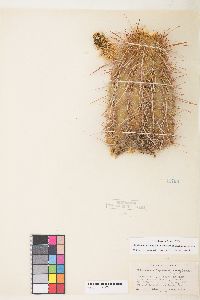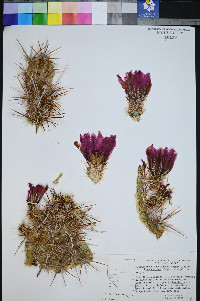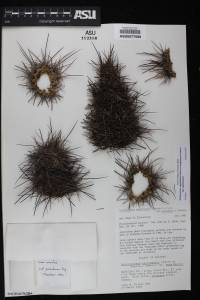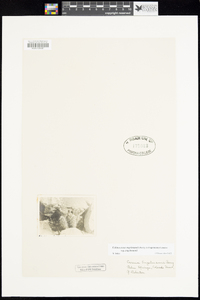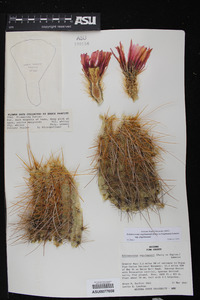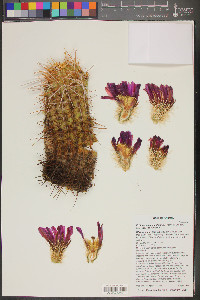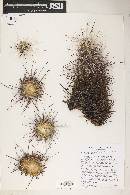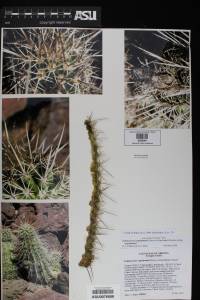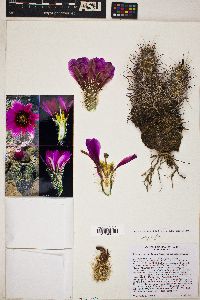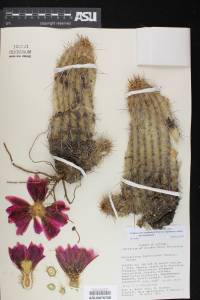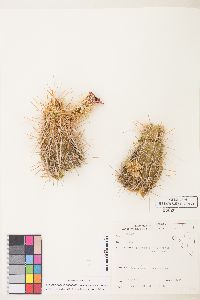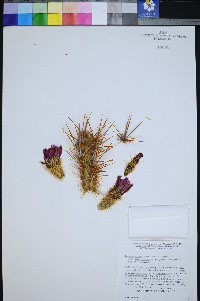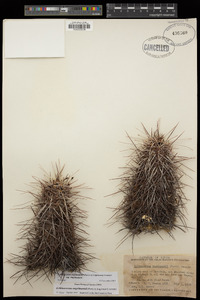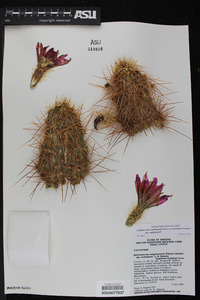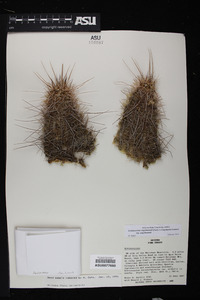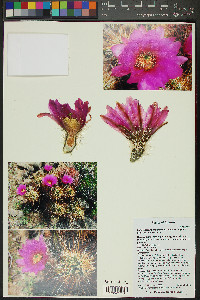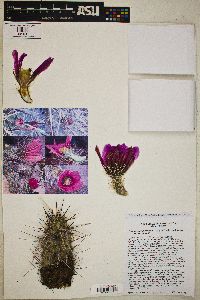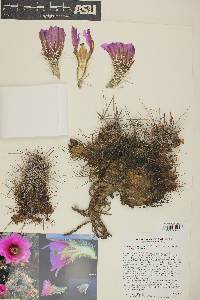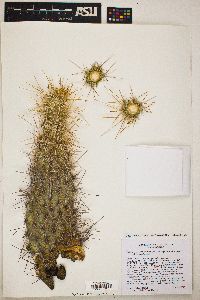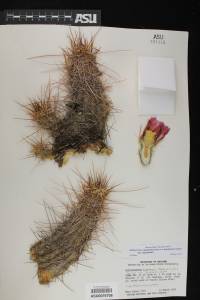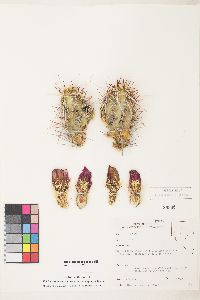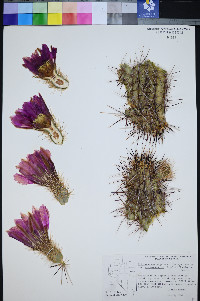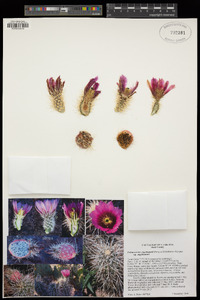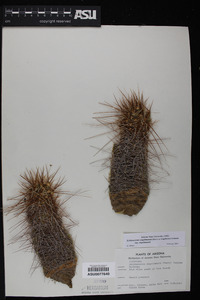Echinocereus engelmannii
|
|
|
|
Family: Cactaceae
Engelmann's hedgehog cactus, more...Saints Cactus, calico cactus, strawberry hedgehog, Engelmann hedgehog, strawberry cactus (es: sinita barbona, cacto fresa, pitahayita)
[Echinocereus decumbens Clover & Jotter, moreEchinocereus engelmanni Lem., Echinocereus engelmannii var. decumbens (Clover & Jotter) L.D. Benson] |
Plants 3-60-branched, ultimately forming somewhat open clumps. Stems mostly erect, cylindric or somewhat tapering distally, (5-)14-45(-70) × 3-9 cm; ribs 10-13, crests slightly undulate; areoles 6-10(-15) mm apart. Spines (8-)15-20 per areole, usually straight (curved and twisted in desert mountains and peninsular ranges of California), individual spines with broad zones of different colors: whitish or grayish, dull golden-yellow, or reddish brown to nearly black; radial spines 6-14 per areole, 8-20(-50) mm; central spines (2-)4-6(-9) per areole, divergent-porrect, 12-70 mm, abaxial central spine often fading whitish, flat to sharply angled (terete or nearly so in north-central Arizona). Flowers 6-9 × 5-9 cm; flower tube 13-30 × 10-30 mm; flower tube hairs 1 mm; inner tepals bright rose-pink to magenta, often varying from paler to darker in same population, proximally darker, 37-75 × (8-)14-25 mm, tips relatively thin, delicate; anthers yellow; nectar chamber 4-6 mm. Fruits red or orangish, 25-45 mm, pulp whitish be-coming infused with pink or red from the skin. 2n = 44. Flowering Mar-Apr; fruiting May-Jul. Sonoran and Mojave deserts, chaparral, pinyon-juniper woodlands; 200-2400 m; Ariz., Calif., Nev., Utah; Mexico (Baja California, Sonora). The characteristics distinguishing Echinocereus engelmannii from E. fasciculatus to the east are poorly documented, and W. Blum et al. (1998) combined the two as separate subspecies of E. engelmannii. Historically, E. engelmannii has been characterized as having the abaxial central spine in each areole particularly long, pale, and strongly compressed dorsiventrally (sharply angled, hence daggerlike), contrasting with the other spines. In practice that trait is not always diagnostic. Plants called Echinocereus engelmannii var. acicularis L. D. Benson are essentially morphologically and geographically intermediate between those referred to E. fasciculatus and E. engelmannii var. chrysocentrus. The history of confusion with Echinocereus nicholii has resulted in misidentification of yellow-spined individuals of E. engelmannii. Spine color polymorphism, common within Echinocereus engelmannii, provided the original basis for varieties chrysocentrus and purpureus. The well-marked, identifiable extremes often occur in populations that include individuals easily assigned to other named varieties, or not assignable to any. L. D. Benson (1969, 1982) and subsequent authors (e.g., N. P. Taylor 1985; W. Blum et al. 1998) have attempted to recognize infraspecific taxa within E. engelmannii. However, one of those is clearly a distinct species (E. nicholii), while the remainder are either too poorly defined or too poorly known to treat fully here. At higher elevations beyond the western edge of the desert, E. engelmannii var. munzii (Parish) P. Pierce & Fosberg has been distinguished by its curving, twisting, gray spines, somewhat resembling spines of westernmost plants of E. triglochidiatus var. mojavensis. Plants of the western Sonoran Desert margin in the Mexican boundary region in California are the typical E. engelmannii var. engelmannii. Similar plants from the opposite, eastern, side of the Sonoran Desert, in Arizona, have been called E. engelmannii var. acicularis L. D. Benson. In the intervening Colorado River Valley is spinier E. engelmannii var. chrysocentrus (Engelmann & J. M. Bigelow) Rümpler. In E. engelmannii var. acicularis at the lowest altitudes, central spines are usually four, in which cases taxonomic segregation from E. engelmannii var. chrysocentrus seems arbitrary. At higher altitudes, plants of E. engelmannii var. acicularis with only one or two central spines per areole are frequent, and the abaxial central spine may be terete instead of angular and daggerlike as in E. engelmannii var. chrysocentrus. The most formidably spiny extremes of the species were segregated as E. engelmannii vars. howei and armatus; however, other individuals in the original populations (type localities) are readily assigned to E. engelmannii var. chrysocentrus. W. Blum et al. (1998) placed all of the above varieties under E. engelmannii subsp. engelmannii. Plants smaller in all parts and with fewer central spines from north-centra Benson 1969, FNA 2003 Common Name: Engelmann's hedgehog cactus Duration: Perennial Protected Status: No status in Arizona. General: Perennial succulent with 3-60 stems that are in open to dense masses or mounds 30-60 cm across with erect cylindric stems that are tapering near top, usually 3-9 cm wide, each with 10-13 ribs, the crests slightly undulate, with areoles 6-10 mm apart. Spines: Usually 15-20 spines per areole, these are usually straight but of variable color, there are 6-14 radial-spines per areole about 8-20 mm long. There are 4-6 central spines per areole, these are divergent and extended forward, with the lower central spine often fading whitish and flat to sharply angled (terete in some areas). Flowers: Tepals rose pink to magenta and varying from paler to darker, overall the flowers are 6-9 cm long and 5-9 cm wide, with a flower tube 13-30 mm by 10-30 mm, the tepal tips thin, and bearing delicate yellow anthers. Fruits: Fleshy fruit red or orangish, 25-45 mm with whitish pulp becoming infused with pink or red. Skin thin, with large and readily detachable spine clusters; fruit juicy, edible; seeds black, tuberculate. Ecology: Found in gravelly, sandy, or rocky soils from 2,000-5,000 ft (610-1524 m), flowers March-April. Distribution: s UT to Sonora and Baja Calif., MEX. Notes: There is extensive variation in this species. For that matter, there are many varieties. FNA discusses some of this variation and the difficulties in distinguishing them. The Benson 1969 key has the separation between E. engelmanii and other species as being the basally flattened principal spine, which is sharp angled in cross section, this species also always has 4 or more central spines according to FNA. Key to field ID are the 4-6 long twisted central spines, 6-14 radial spines, all of which are yellow to white. Ethnobotany: The ripe fruits were eaten raw or boiled and then eaten. Etymology: Echinocereus is from the Greek echinos, hedgehog or spine and cereus, waxy, while engelmannii is named for Georg Engelmann (1809-1884) a German born, American botanical collector. Synonyms: Cereus engelmannii, Cereus munzii, Echinocereus engelmannii var. acicularis, Echinocereus engelmannii var. armatus, Echinocereus engelmannii var. chrysocentrus, Echinocereus engelmannii var. howei, Echinocereus engelmannii var. munzii Editor: SBuckley, 2010 |
|
|
|

